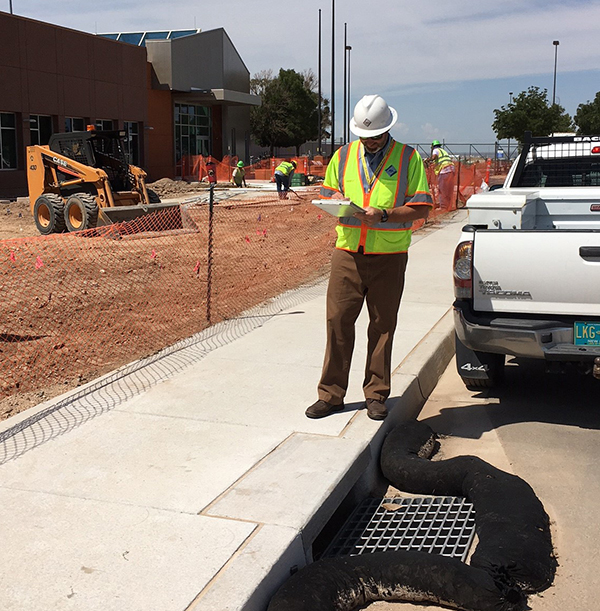Sandia’s clean water stewards focus on stormwater runoff

Environmental technical professional John Kay (4141) inspects a construction site at Sandia before a storm to ensure proper protection measures are in place near stormwater drains.
is well underway in New Mexico and other areas across the Southwest. The
caused by monsoon storms occur with little or no warning, move at very fast speeds, and can bring walls of water 10 to 20 feet high.
In addition to the safety hazards that storms can rain down, the stormwater generated in almost an instant can pick up debris from roads, chemicals from lawns, oil from cars, and bacteria from animal waste. Many people are unware or forget that storm drains lead directly to open water bodies without any treatment, which is different than sanitary sewers that divert waste water to a treatment plant. All the trash and pollutants picked up by stormwater then pour into drains and arroyos and compromise water quality.
While the unpredictability of severe storms can wreak havoc, Sandia’s Stormwater Program is deliberate and constant as it works to develop strategies to prevent and reduce pollutants from entering the local ecosystem.
We work with members of our workforce to help them understand how their work may adversely impact stormwater quality.
We work with members of our workforce to help them understand how their work may adversely impact stormwater quality," says Kathie Deal (4141), environmental technical professional and Stormwater Program lead in the Environmental Compliance and Monitoring Department.
“The Rio Grande is one of New Mexico’s greatest treasures,” adds Kathie. “It’s a critical habitat for many bird and fish species and a municipal, agricultural, and recreational water resource to local communities. Sandia is committed to protecting the Rio Grande, its tributaries, and the surrounding environment.”
As Sandia strives to be a good steward of the environment, federal and local regulations provide the framework to achieve this goal. The National Pollutant Discharge Elimination System (NPDES), which is administered by the US Environmental Protection Agency, controls water pollution by regulating sources that discharge pollutants into waters of the United States. Sandia/New Mexico holds three NPDES permits that detail allowable activities and reporting mechanisms for discharging stormwater system to the Rio Grande or its tributaries (e.g., Tijeras Arroyo).
“We’re aware that not everyone can know about the specifics of environmental regulations; that’s why we’re here to provide consultation on the requirements and to offer training so customers can effectively integrate pollution prevention measures into their mission-critical work,” says Carolyn Daniel (4141), environmental technical professional and one of the three permitting leads for the program.
Areas and activities that have the most potential to create stormwater pollutants at Sandia are landscaping, waste stockpiles, and maintenance and construction activities. Members of the workforce involved in these types of activities are required to take Stormwater Pollution Prevention training (SW100 and SW200).
“While one purpose of our stormwater program training is to help Sandia comply with regulations, the course also shares best practices that help us all work together toward preserving natural resources,” Carolyn says.